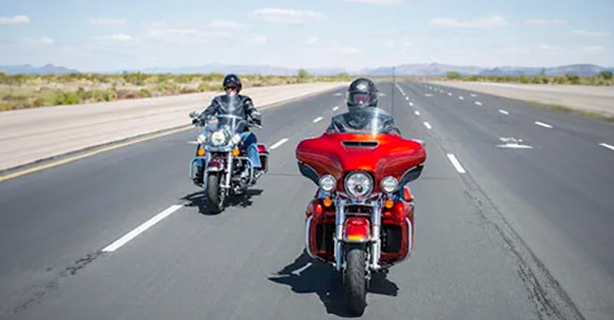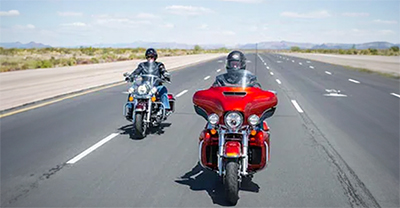Passing safely on a motorcycle is all about awareness, preparation, and quick decision-making. Whether you're riding solo, with a passenger, or in a group, always take a cautious and calculated approach. By mastering these strategies, you could reduce risks and enjoy a smoother, safer ride each time you hit the road.
Overtaking is a circumstance so common to riding and driving that it might seem mundane. It's not.
In fact, passing another motorist exposes you to additional risks and hazards in many riding situations, which is why each of us should utilize key strategies before making the decision to overtake or pass another vehicle.
Here are eleven strategies for passing (and being passed) safely.
1. NO UNNECESSARY RISKS
First, ask yourself why you want to pass. Are you on your motorcycle because you're trying to get somewhere or because you enjoy the ride? It’s best to evaluate if you are mentally ready to ride and not tired, stressed, or distracted? Are you confident in your skills in the environment you are riding in to execute a pass? Are you able to focus on evaluating potential hazards and can perform the proper actions to avoid them? If you’re questioning your ability after evaluating your current state, then maybe it's best to find that peaceful pace that flows with other motorists rather than passing them.
In most circumstances, if you decide not to pass someone, you've reduced your exposure to potential collision risks such as attempting to pass a vehicle slowing for a turn in your intended path of travel or another vehicle ahead of you also attempting to pass.
2. KEY STEPS TO PASSING
Total abstinence from overtaking isn't too likely for most riders, so let's consider how to pass safely and effectively. That means employing this basic blueprint for most passing maneuvers you make:
Constantly scan the road ahead and behind, in both the passing lane and the cruising lane. Select a lane position and following distance which will expand your field of view to search for potential hazards and evaluate if you have a safe passing gap ahead. Avoid trying to pass more than one vehicle at a time.
Signal your intention to pass. Check your mirrors and turn your head to check your blind spots.
Initiate the maneuver while accelerating
Select a lane position in the overtaking lane which gives you sufficient space around the vehicle you're passing
Once you have sufficient room in front of the vehicle you're going around, signal to merge back to the original cruising lane
Merge and decelerate to the desired speed
That's the basic outline for passing another vehicle and should be used for most overtaking maneuvers. Yet, there's a lot of nuances in the details and varying circumstances of some situations.
3. TWO WAYS TO EXECUTE A PASS
When overtaking another motorist, you're faced with a decision to either simply roll on the throttle to build some speed, or to downshift to take advantage of the higher gear ratio at the same engine speed and then roll on the throttle. Downshifting then rolling on the throttle to initiate a pass is typically utilized if a quicker rate of acceleration is desired to pass or overtake a vehicle, hit the gas and use a more sudden burst of acceleration to pass.
The solution: Utilize the method of acceleration that best fits the environment, motorcycle, and situation you are in but pass decisively and quickly, utilizing your motorcycle's ability to accelerate.
4. PASSING WITH A PASSENGER
The strategy changes when overtaking while your motorcycle is loaded with a passenger or the weight of extra gear. If your bike is fully loaded, ride with the premise that you're not going to pass unless it's necessary. A loaded motorcycle takes more time to accelerate and decelerate.
For those occasions when you must pass while riding fully loaded, keep in mind that a fully loaded motorcycle doesn’t accelerate as quickly as when your motorcycle is lightly loaded and you’re riding solo. Give yourself more time and space before initiating the passing maneuver and be aware that you may have to adjust your throttle inputs to account for the additional load to achieve a rate of acceleration sufficient for passing.
Use the same rationale as passing unloaded: use the method that consumes the least amount of time to complete the pass. With a loaded motorcycle, use smooth throttle inputs and adjust your rate of acceleration in order to build speed to complete the pass.
5. PASSING IN FARM COUNTRY
A ride through rural Pennsylvania or Wisconsin can make you acutely aware of the unique hazards associated with passing slow-moving farm machinery.
Someone driving farm equipment like a tractor or combine poses added challenges and hazards to a motorcyclist. This equipment is usually wide and can hang into a second lane. Sometimes, operators can't see or aren't paying attention to motorists behind them. They might not have working lights or turn signals. Their equipment is cumbersome and can sling dirt onto the road, and they might abruptly turn into fields without a marked or visible driveway.
Pay attention to these hazards for clues to directional changes a farmer might make in his/her route, such as the telltale sign of dirt chunks going into and out of fields, as well as other equipment being operated in upcoming fields.
6. PASSING SAFELY IN A GROUP
If you're among a group of riders who are about to pass a motorist, agree in advance on how the group will or will not pass and follow that guidance while still making your own safety decisions.
It is a mistake to blindly follow the lead of the rider in front of you. For starters, that rider might have very different sensibilities than you about what constitutes a safe situation for passing. Secondly, even if the situation was safe for his or her pass, it might have changed by the time you're ready to do so.
The best approach is to employ the same strategies and sensibilities used when riding solo. If you're riding within a group and decide to pass a motorist, be extra cautious to look behind you before initiating any passing maneuvers. Others in the group behind you might not share your same caution and could decide to pass before it's their turn.
7. CONSIDER ROAD CONDITIONS
Wet, gravelly, or uneven surfaces can dramatically affect how you approach initiating a passing maneuver.
Before initiating a pass, always assess the road surface and visibility conditions. Wet roads, gravel, or debris can reduce your bike’s traction, making a pass more hazardous. Dense fog, rain, or terrain blocking view and other road users may impact visibility limiting reaction times.
Bottom line, avoid passing when road conditions are less than ideal, or slow down to account for potential hazards. Always prioritize caution. If road conditions are not ideal, it may be best to wait and pass when it’s safer to do so.
8. CHECK YOUR BLIND SPOTS AND MIRRORS
Motorcycles offer a more limited view compared to cars, and checking your blind spots and mirrors is one of the most critical steps in making a safe passing maneuver.
Your blind spots are typically located directly behind your left and right shoulders. Additionally, the area directly behind your motorcycle can also be considered a blind spot, especially if a vehicle is following too closely. This makes it vital to physically turn your head and check these areas in your blind spots before making any moves on the road.
Remember that larger vehicles, like trucks and buses, have significantly larger blind spots, making it harder for them to see you, so give them extra space.
9. MAINTAIN SAFE FOLLOWING DISTANCE BEFORE PASSING
Maintaining a safe following distance is one of the most important aspects of riding defensively and preparing for a safe passing maneuver. Following too closely reduces your reaction time if the vehicle you're following suddenly slows down or stops and limits your visibility of road conditions ahead.
A general guideline for maintaining a minimal safe following distance on a motorcycle is the "2-second visual lead time." To apply it, choose a stationary object on the road (like a sign or tree) and count the time it takes for you to reach that object after the vehicle ahead passes it. If it takes less than two seconds, you’re following too closely, and you should back off to create more space. In adverse conditions (such as rain or poor visibility due to fog), increase this to 3-4 seconds or more.
Remember to adapt your following distance based on road conditions, traffic, and the type of vehicle you’re following, always prioritizing safety over speed.
10. NIGHTTIME PASSING CONSIDERATIONS
Riding at dusk or at night presents additional risks, including reduced depth perception, which can make it harder to accurately gauge the speed and distance of the vehicle you’re overtaking.
When passing at night, use extra caution and use road markings to stay oriented. Use them as guides, especially when overtaking on dark or rural roads where visibility may be limited. Ensure you're positioned properly before and after the pass to avoid drifting into the other lane.
Be alert for reflective surfaces that indicate potential hazards, such as animals, road signs, or even debris. Reflective signs can also provide early warning of sharp turns or junctions, which is essential for planning your pass.
11. HOW TO GET PASSED
How to handle occasions when you're the one getting passed? It's best to leave your ego at the door, do your scan of the situation and allow the pass to occur as safely as possible.
If you assess the situation and it allows for the other road user to pass you, then stay the course and don't make any unexpected changes that could distract the overtaking vehicle. But be prepared to change that tactic if the overtaking vehicle creates a new hazard and have a plan for it. If you see a motorist roll out to pass, then look at all the factors on the road.
You want them to have a choice to go in front of you as well as the ability to change their decision and come in behind you. That might mean changing position in the lane to free up space and slowing down.
Below are some good best practices to follow when getting passed:
Hold a Steady Speed: Don’t accelerate or decelerate suddenly, as this can confuse the passing driver and make the maneuver more dangerous for both of you.
Avoid Swerving: Sudden lane changes or drifting within your lane can make the pass more dangerous and increase the risk of an incident.
Create Space for the Passing Vehicle: Shift slightly within your lane to the side farthest from the passing vehicle. This small adjustment provides more room for the overtaking vehicle to complete the pass safely without crowding you.
Use Turn Signals: If you plan to change lanes or make a turn while being passed, ensure you signal your intentions well in advance. This allows the passing vehicle to adjust its maneuver.
Avoid Misleading Signals: Don’t turn on your signal to pass or change lanes if another vehicle is already attempting to pass you.
Don’t Speed Up During the Pass: Resist the urge to “race” or keep pace with the passing vehicle. Instead, hold a consistent speed or, if necessary, gently ease off the throttle to give the passing vehicle more space to complete the maneuver safely.
Trucks and Buses: If a large vehicle passes you, consider moving slightly to the opposite side of your lane to avoid the wind blast and maintain stability.
Use Hand Signals if Necessary: If you feel that the vehicle passing you is unaware of your position or the situation around them, consider using hand signals to communicate.
ADDITIONAL TIPS ON PASSING SAFELY
Here are a few more valuable tips for safe passage:
If you're about to pass another vehicle, always check behind you before initiating the move to ensure that a motorist behind you isn't doing the same thing at that exact moment.
Avoid passing more than one vehicle at a time or passing as a group by tailgating an overtaking vehicle in front of you.
In most states, a motorcycle owns the entire lane. So, if you're passing another motorcyclist, be sure to pass them in a different lane instead of using the same lane.
When riding in multiple traffic lanes, always try to pass on the left whenever possible. If it's just you, it's okay to pass on the right. But if you're riding in a group, passing should occur on the left.
When deciding whether to pass on the left of a slowing vehicle, don’t assume they are simply coming to a stop or turning right; anticipate that they may be turning left and could enter your path of travel if you attempt a pass. Avoid passing in these situations to avoid the risk of a collision. The same can also be said for the assessing a pass to the right as well.
Be wary of anything that's out of the ordinary that could result in other motorists' sudden directional changes. Likewise, if you're near a tourist attraction or other popular landmark, be prepared for last-second maneuvers by other drivers. And always consider someone driving slowly as a possibility for a non-signaled, unsafe U-turn.
In a nutshell, be cautious, aware, and thoughtful about your environment.
Related Reading:
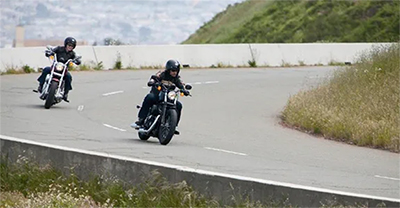
Cornering confidence will determine if a sign indicating ‘bends ahead’ results in a whoop of joy, or feelings of dread. Here’s how to advance beyond the cornering basics.
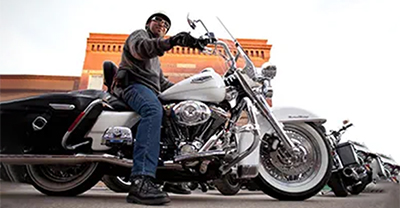
While motorcycle rallies serve up the best experiences available for motorcyclists, they also come with their share of challenges. Rally like a pro with these tips!
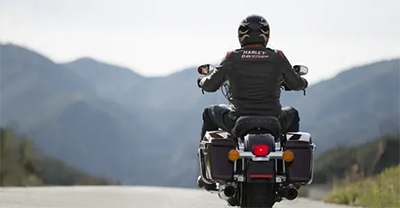
Dehydration and heatstroke are serious matters and can sneak up on you on long rides. It pays to know the warning signs and how to prevent them. Learn more!
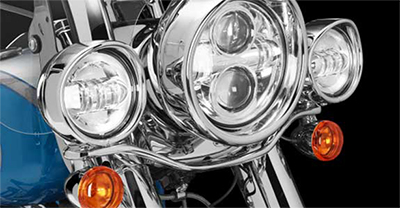
A motorcycle rider’s best defense is to take active measures to make themselves more visible. Here are a few ways to become more visible on the road.

